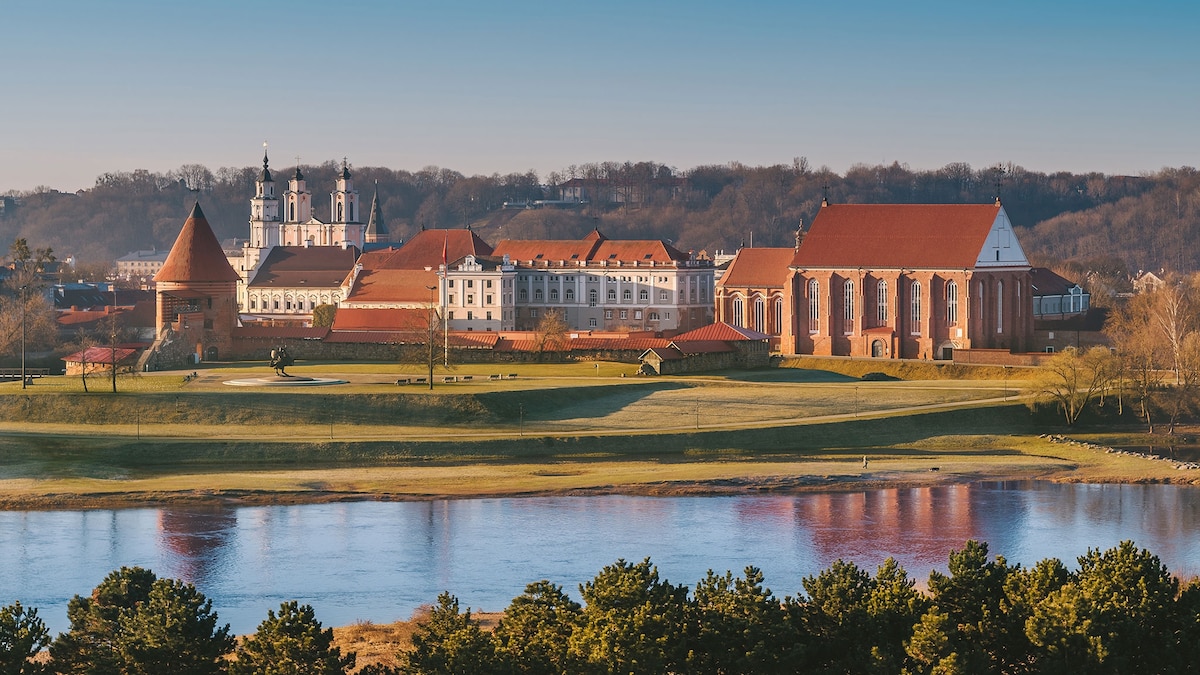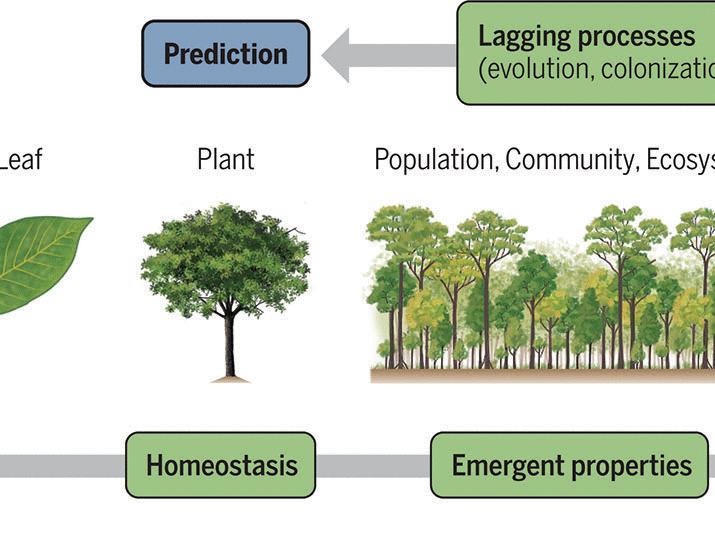Now Reading: A first-timer’s guide to Kaunas, Lithuania’s timeless city
-
01
A first-timer’s guide to Kaunas, Lithuania’s timeless city
A first-timer’s guide to Kaunas, Lithuania’s timeless city

Kaunas has had numerous rulers over time, from the Teutonic Knights to the Russian Empire. Nonetheless, throughout the years, Lithuania’s second city (the fourth-largest in the Baltic states) has maintained its identity as a centre of culture and academia. Situated 62 miles west of Vilnius, Kaunas’ architecture hints at the city’s great historical depth — from the gothic spires of its medieval Senamiestis (Old Town) to its angular art deco apartment buildings and ultra-modern additions such as the new Science Island. Here’s how to experience it all in a weekend.
When to visit
Get ahead of the summer crowds by visiting Kaunas in spring, when the Sakura Park cherry blossoms on Nemunas Island are in bloom. Cultural season kicks off in April with the Kaunas Jazz Festival. In late May, the city celebrates its birthday with grand concerts, performances and the lively Putvinskis Street Day, while another highlight is the Celebrate the River initiative, which encourages exploration of the Nemunas and Neris rivers. Cap your month of culture off with the Pažaislis Music Festival (celebrating its 30th season this year), which launches its summer-long programme at the end of May.
July and August are the peak months in Kaunas, when the Old Town hums with activity, pavement cafes stay open late and locals take to the waters of the Kaunas Lagoon Regional Park on boats. Art buffs should attend the Kaunas Culture Fair and Kaunas Biennial, both in September. An off-season winter break involves browsing Christmas markets, sledding in Kleboniškis Forest Park, walking through the wintery Oak Grove and exploring a snow-dusted Old Town with the added spectacle of 300 illuminated trees.

Kaunas Castle is a prominent landmark in Kaunas’s Old Town.
Photograph by A. Aleksandravičius, Kaunas IN

Christ’s Resurrection Basilica is a stunning example of modernist architecture in the New Town.
Photograph by A. Aleksandravičius, Kaunas IN
What to see
The medieval Kaunas Castle and its grounds sit at the confluence of the Nemunas and the Neris Rivers, and its ramparts offer the perfect spot to look out over the city’s Old Town. Afterwards, hit the cobbles of the pedestrianised Vilniaus Street, where many of the buildings — now featuring an array of open-air cafes, restaurants and boutiques — date back to the 16th century.
The Cathedral-Basilica of St Peter and St Paul is an impressive example of Gothic design that sits at the edge of the Town Hall Square, while the distinctive Kaunas Town Hall (nicknamed ‘The White Swan’), towers above it. The stately building —formerly a prison — has been turned into an architecture school which houses the Kaunas City Museum, with its extensive history, science, culture and art exhibitions.
Beyond the Old Town, the low-rise Naujamiestis (New Town) extends east, binding the two halves of the city’s personality together with its ensemble of modernist buildings — the area was also designated a UNESCO World Heritage Site in 2023. Look out for Christ’s Resurrection Basilica here, a modernist Roman Catholic church that towers over the neighbourhood of Žaliakalnis (literally ‘the green hill’), and is accessible by funicular.
Wander down Putvinskio Street and Laisvės Avenue to check off other key interwar edifices, including the Kaunas Artists’ House. The nearby Art Deco Museum transports visitors back to 1929, when Kaunas was Lithuania’s provisional capital. Get a feel for the zeitgeist on a tour of its authentically restored art deco apartment, which is brought to life by guides who recount the stories of its former residents. Another interesting time-travel experience can be found at the Amsterdam School Museum, which combines Art Deco and Art Nouveau elements.

Follow the Street Art Route around Kaunas to see the city’s many murals and art museums.
Photograph by A. Aleksandravičius, Kaunas IN
What to do
When it comes to exploring Kaunas’s art scene, you’re spoiled for choice. The MK Čiurlionis Museum of Art examines the legacy of the 19th-century painter and composer, while the Kaunas Picture Gallery extends to modern Lithuanian and international art. Set in a residential courtyard, the open-air Yard Gallery provides a window to contemporary urban life with its guerrilla paintings and installations. It’s part of the Street Art Route, which weaves around the city, taking in iconic murals such as The Wise Old Man, a four-storey tribute to influential Kaunas-born artist Jurgis Maciunas, painted on the side of a former footwear factory in the Old Town.
An islet in the Nemunas River hosts the futuristic Science Island, the country’s first science and innovation promotion centre, where a planetarium and permanent collection of 140 interactive exhibits were inaugurated late last year. Nemunas Island is also home to Žalgirio Arena, a temple to basketball, Lithuania’s national sport. Here, visitors can immerse themselves in the game’s culture by cheering on the home team, BC Žalgiris Kaunas.

The newly opened Science Island (Mokslo Sala) has added to Kaunas’s collection of unique architectural landmarks.
Photograph by A. Aleksandravičius, Kaunas IN
Where to eat
Known for its wild game offerings, Kaunas is a carnivore’s delight. Take a friend to Medžiotojų Užeiga for a sharing plate of venison meatballs, roe steaks and boar sausages. Bernelių Užeiga meanwhile specialises in rustic national dishes including zeppelins, jumbo potato dumplings stuffed with cottage cheese, mushrooms or meat, and šaltibarščiai, a chilled soup made with beetroot, kefir, cucumbers, onions and dill.
The Michelin Guide Lithuania debuted in 2024 with five recommended restaurants in Kaunas, including Uoksas, which applies Nordic aesthetics to Baltic produce for dishes such as sturgeon with black truffle and fermented beets. Also in the Guide, Monte Pacis — housed in a beautiful, Baroque-style Pažaislis Monastery — presents a tasting menu that focuses on seasonal, locally sourced ingredients, including vegetables grown in their garden.
To step back in time, pull up a bar stool at Spurginė, and a member of the waiting staff will slide a plate of doughnuts across the wood-panelled bar. The recipe — like the decor — remains unchanged since the Soviet era.
Where to stay
Base yourself in Kaunas’s central area: either in the Old Town for immersive architecture and river views, or closer to the New Town if your priority is restaurants and nightlife. The four-star Viešbutis Kaunas, once a wine merchant’s shop, offers unfussy rooms behind its historic facade on Laisvės Avenue in the New Town. Meanwhile in the Old Town, Boheme House’s eight apartments are each styled to reflect a different side of Kaunas’s interwar bohemianism, and Daugirdas marries old and new with both a 16th-century wine cellar and a contemporary guest wing with a terrace bar.
This paid content article was created for Visit Kaunas. It does not necessarily reflect the views of National Geographic, National Geographic Traveller (UK) or their editorial staffs.
To subscribe to National Geographic Traveller (UK) magazine click here.
(Available in select countries only).























